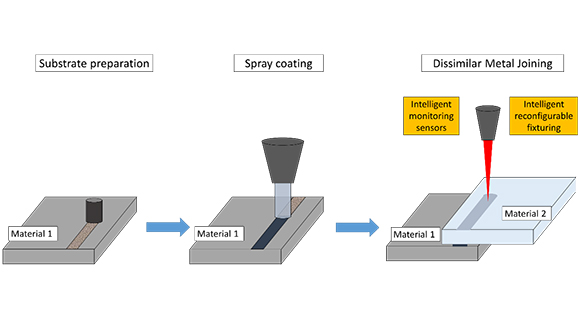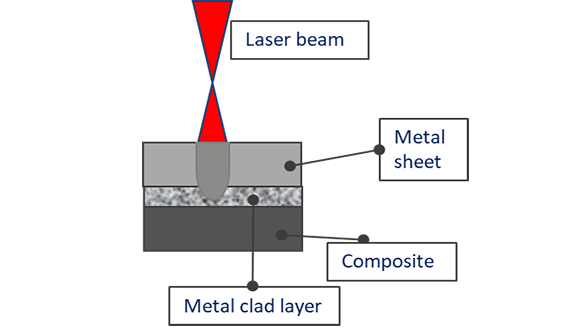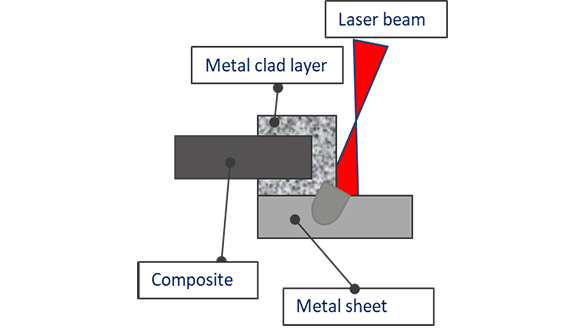Wed, 25 September, 2019
TWI has joined a consortium of businesses for a project to develop and validate a new technology for joining composite to metal parts. The Ultimate Project, which is funded by Innovate UK, began in April 2019 and is set to last for 36 months. The consortium is made up of five partners; CAV Advanced Technologies (CAVAT), Gestamp UK, Curtiss-Wright Surface Technologies (CWST), FAR-UK and The Welding Institute (TWI).
Background
Industries in the transport sector, including aerospace and automotive, have an interest in exploring innovative solutions for joining dissimilar materials, with the key drivers being to:
- Reduce the weight of structures – light-weighting reduces CO2 emissions and improves fuel economy
- Enable novel design of vehicles in order to optimise performance. Engineered functional structures could be made by the integration of different materials selectively associated to different components
Traditional methods for multi-material assemblies include adhesive bonding and mechanical fastening. However, joining metallurgically incompatible metal alloys or CFRP composites to metal alloys is challenging and often beyond the capacity of a conventional automated production processes. Currently, most challenging multi-material assemblies are mechanically fastened and/or adhesive bonded. Limitations associated to using these two techniques include extra weight, cost and durability issues. These drawbacks limit the adoption of more advanced multi-material joining applications and reduce the potential benefits of optimised designs. Consequently, there is a clear need for new, flexible, cost-effective and rapid methods for joining dissimilar materials, capable of meeting industry performance and manufacturing demands.
The Ultimate Project aims to address these challenges through the development of an innovative technology to enable highly dissimilar materials to be fusion welded together using productive industrial processes. The project will primarily focus on dissimilar material combinations of interest to the transport sector, including dissimilar metallic materials, and composite to metallic material joints. Case studies and technology demonstrators will be produced for the aerospace and automotive sectors, although the technology has the potential to be highly versatile and applied to many different applications across other industry sectors.
Concept
The technology will be initially developed at lab scale and then validated across relevant case studies indicated by the end users, in order to promote the industry uptake.
The scope is to develop laser welding solutions for joining composite to metal parts in an overlap joint configuration, with the technology made up of the following phases:
- Surface preparation of the dissimilar materials, using cold plasma or short-pulse laser technology, depending upon the material and metal spraying process (see below)
- Metal spraying of a high quality, thin (<500µm) metal interlayer on one of the dissimilar materials, with the interlayer being of a chemical composition compatible with the other dissimilar material
- Laser welding with penetration depth control, intelligent fixturing and on-line QA to produce an overlap weld between one of the dissimilar materials and the interlayer, at speeds \>10m/min
Objectives
The overall objectives are to develop laser welding solutions for joining composite to metal parts in an overlap joint configuration. This approach can be exploited over different joining configurations as captured by the pictures (below). The Ultimate Project will also include the integration and validation of intelligent fixturing and on-line quality assurance (QA), capable of performing real-time monitoring of weld depths during processing. Once complete, the technology will be demonstrated on industrially-relevant case studies from the aerospace and automotive sectors.
 Figure 1. Ultimate general concept for composite to metal joining
Figure 1. Ultimate general concept for composite to metal joining
 Figure 2. Composite to metal joint in lap configuration
Figure 2. Composite to metal joint in lap configuration
 Figure 3. Composite to metal joint in fillet configuration
Figure 3. Composite to metal joint in fillet configuration